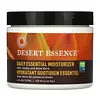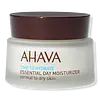What's inside
What's inside
 Key Ingredients
Key Ingredients

 Benefits
Benefits

 Concerns
Concerns

 Ingredients Side-by-side
Ingredients Side-by-side

Water
Skin ConditioningAloe Barbadensis Leaf Juice
Skin ConditioningGlyceryl Stearate
EmollientStearic Acid
CleansingCetyl Palmitate
EmollientSimmondsia Chinensis Seed Oil
EmollientCarthamus Tinctorius Seed Oil
MaskingCetyl Alcohol
EmollientPropanediol
SolventSesamum Indicum Seed Oil
EmollientGlycerin
HumectantGluconolactone
Skin ConditioningSodium Hydroxide
BufferingSodium Benzoate
MaskingGeranium Maculatum Oil
MaskingWater
Skin ConditioningEthylhexyl Palmitate
EmollientIsopropyl Myristate
EmollientGlyceryl Stearate
EmollientCetyl Alcohol
EmollientPropanediol
SolventGlycerin
HumectantPEG-40 Stearate
EmulsifyingSorbitan Tristearate
EmulsifyingPhenoxyethanol
PreservativeDimethicone
EmollientSodium Benzoate
MaskingAllantoin
Skin ConditioningUrea
BufferingCaprylyl Glycol
EmollientChlorphenesin
AntimicrobialSaccharide Hydrolysate
HumectantParfum
MaskingLinalool
PerfumingHexyl Cinnamal
PerfumingLactic Acid
BufferingPotassium Sorbate
PreservativeAlanine
MaskingGlycine
BufferingMagnesium Aspartate
Skin ConditioningCreatine
Skin ConditioningAloe Barbadensis Leaf Juice
Skin ConditioningTocopherol
AntioxidantMaris Aqua
HumectantWater, Ethylhexyl Palmitate, Isopropyl Myristate, Glyceryl Stearate, Cetyl Alcohol, Propanediol, Glycerin, PEG-40 Stearate, Sorbitan Tristearate, Phenoxyethanol, Dimethicone, Sodium Benzoate, Allantoin, Urea, Caprylyl Glycol, Chlorphenesin, Saccharide Hydrolysate, Parfum, Linalool, Hexyl Cinnamal, Lactic Acid, Potassium Sorbate, Alanine, Glycine, Magnesium Aspartate, Creatine, Aloe Barbadensis Leaf Juice, Tocopherol, Maris Aqua
Ingredients Explained
These ingredients are found in both products.
Ingredients higher up in an ingredient list are typically present in a larger amount.
Aloe Barbadensis Leaf Juice comes from leaves of the aloe plant. Aloe Barbadensis Leaf Juice is best known for helping to soothe sunburns. It is also anti-inflammatory, moisturizing, antiseptic, and can help heal wounds.
Aloe is packed with good stuff including Vitamins A, C, and E. These vitamins are antioxidants, which help fight free-radicals and the damage they may cause. Free-radicals are molecules that may damage your skin cells, such as pollution.
Aloe Barbadensis Leaf Juice also contains sugars. These sugars come in the form of monosaccharides and polysaccharides, folic acid, and choline. These sugars are able to help bind moisture to skin.
It also contains minerals such as calcium, 12 anthraquinones, fatty acids, amino acids, and Vitamin B12.
Learn more about Aloe Barbadensis Leaf JuiceCetyl Alcohol is a fatty alcohol. Fatty Alcohols are most often used as an emollient or to thicken a product.
Its main roles are:
Though it has "alcohol" in the name, it is not related to denatured alcohol or ethyl alcohol.
The FDA allows products labeled "alcohol-free" to have fatty alcohols.
Learn more about Cetyl AlcoholGlycerin is already naturally found in your skin. It helps moisturize and protect your skin.
A study from 2016 found glycerin to be more effective as a humectant than AHAs and hyaluronic acid.
As a humectant, it helps the skin stay hydrated by pulling moisture to your skin. The low molecular weight of glycerin allows it to pull moisture into the deeper layers of your skin.
Hydrated skin improves your skin barrier; Your skin barrier helps protect against irritants and bacteria.
Glycerin has also been found to have antimicrobial and antiviral properties. Due to these properties, glycerin is often used in wound and burn treatments.
In cosmetics, glycerin is usually derived from plants such as soybean or palm. However, it can also be sourced from animals, such as tallow or animal fat.
This ingredient is organic, colorless, odorless, and non-toxic.
Glycerin is the name for this ingredient in American English. British English uses Glycerol/Glycerine.
Learn more about GlycerinGlyceryl Stearate is a mix of glycerin and stearic acid.
It is used to stabilize the mixing of water and oil ingredients. By preventing these ingredients from separating, it can help elongate shelf life. It can also help thicken the product's texture.
As an emollient, it helps soften skin and supports barrier-replenishing ingredients.
In cosmetics, Glyceryl Stearate is often made from vegetable oils or synthetically produced.
This ingredient may not be fungal-acne safe
Fun fact: The human body also creates Glyceryl Stearate naturally.
Learn more about Glyceryl StearatePropanediol is an all-star ingredient. It softens, hydrates, and smooths the skin.
It’s often used to:
Propanediol is not likely to cause sensitivity and considered safe to use. It is derived from corn or petroleum with a clear color and no scent.
Learn more about PropanediolSodium Benzoate is a preservative. It's used in both cosmetic and food products to inhibit the growth of mold and bacteria. It is typically produced synthetically.
Both the US FDA and EU Health Committee have approved the use of sodium benzoate. In the US, levels of 0.1% (of the total product) are allowed.
Sodium benzoate works as a preservative by inhibiting the growth of bacteria inside of cells. It prevents the cell from fermenting a type of sugar using an enzyme called phosphofructokinase.
It is the salt of benzoic acid. Foods containing sodium benzoate include soda, salad dressings, condiments, fruit juices, wines, and snack foods.
Studies for using ascorbic acid and sodium benzoate in cosmetics are lacking, especially in skincare routines with multiple steps.
We always recommend speaking with a professional, such as a dermatologist, if you have any concerns.
Learn more about Sodium BenzoateWater. It's the most common cosmetic ingredient of all. You'll usually see it at the top of ingredient lists, meaning that it makes up the largest part of the product.
So why is it so popular? Water most often acts as a solvent - this means that it helps dissolve other ingredients into the formulation.
You'll also recognize water as that liquid we all need to stay alive. If you see this, drink a glass of water. Stay hydrated!
Learn more about Water